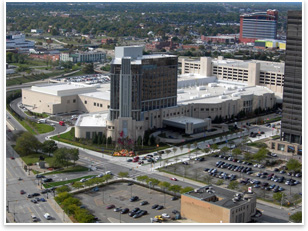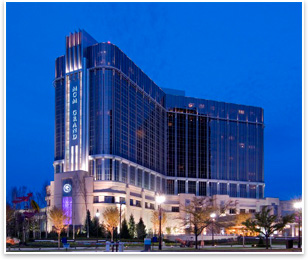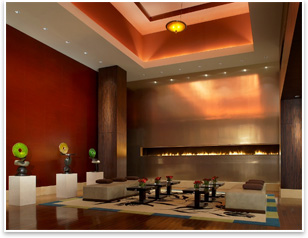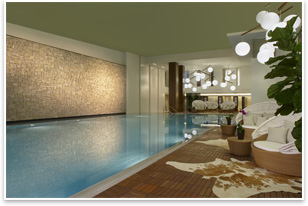
MGM Grand
Bets on Detroit by Zach Mortice
How do you . . . design a building whose programmatic needs are at odds with the popular aesthetic of its environment?
“We put that paradox on the table right at the beginning,” says Tom Sherry, AIA, design principal with Hamilton Anderson. The solution the team came up with was a slick chrome and glass Neo-Art Deco 18-story hotel tower. The boomerang-shaped hotel is grounded in a pre-cast concrete base that simulates limestone and encompasses the sprawling casino complex. It’s sited in the northwest quadrant of downtown Detroit and faces the city center. “The Deco, early 20th century-style lines and detailing [bring] the energy and excitement of an entertainment property,” says Sherry.
Sherry says MGM was sensitive to their site and sensibility dilemma, and were prepared to scale down their trademark Vegas Strip flamboyance enough to make the casino fit in a Midwestern downtown. “They were leading us and we were leading them,” he says. “Where we ended up was with something that does walk the line and is something that is not easily described. It’s not a theme building. It’s not a one-liner like a lot of the Vegas work.” Rapid rise “It was kind of like the start of a marathon,” says Sherry.
The casino is just one stream among rivers of money that have been flowing back into downtown. Over the past decade, the central business district has absorbed more than $15 billion in investment money, according to the Hartford Courant. The recent construction of two large sports stadiums downtown are part of this revival, as was General Motors sentimental move to downtown in 1996. The MGM Grand Detroit isn’t the only resort-style hotel casino coming to town. Detroit is already the nation’s fifth largest gambling market, and $1.5 billion are being spent to bring two more casinos on line, according to the Associated Press. The MotorCity Casino Hotel markets itself as “Detroit’s first high-performance casino” and has embraced the city’s automotive history with enthusiastic kitsch—light fixtures shaped like hubcaps and wall covering that resemble 1950s-style car upholstery.
For his part, Carroll is glad for the tax revenue and 1,000 new
jobs the development will create. “If [MGM] didn’t
do it here, they would do it somewhere else,” he says. |
||
Copyright 2007 The American Institute of Architects. All rights reserved. Home Page |
||
home
news headlines
practice
business
design
recent related
› Planting
Community in
Fallow Fields
Photos:
1. The casino hotel blends great drama with Midwestern respectability.
Photo courtesy of the architect.
2. Night rendering, courtesy of the architect.
3. Hamilton Anderson/SmithGroup Joint Venture (HAA/SG) is the Architect
of Record for the hotel and casino. Photo © Curt Clayton.
4. Laurence Lee Associates served as interior designer for the hotel (shown
is the lobby) and casino. Photo © Beth Singer.
5. Tonychi and associates designed Immerse, the facility’s pool and
spa. Photo © Beth Singer.





